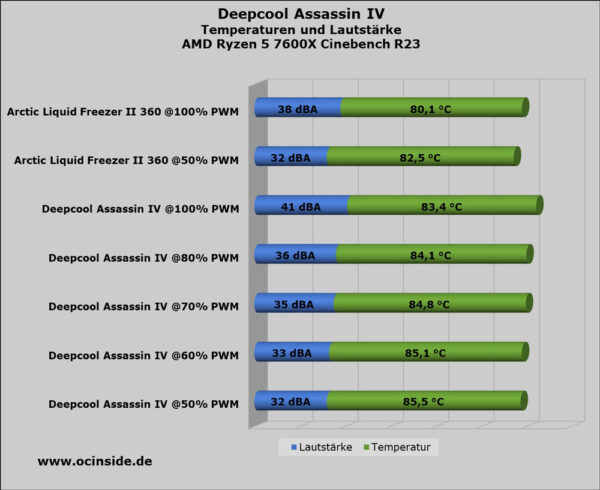
Test setup and results …
We collected the following measured values for the DeepCool Assassin IV on our AM5 test system, which consists of the following components.
| Motherboard | ASRock B650E Taichi with M.2 PCIe 4.0 x4 interface |
| SSD | Crucial P5 Plus 1TB M.2 PCIe 4.0 NVMe-1.4 CT1000P5PSSD8 |
| CPU | AMD Ryzen 5 7600X |
| RAM | 2x 16GB DDR5-6400 |
| PSU | Cooler Master V750 Gold |
| Graphics card | AMD Radeon RX6800XT |
| Case | Fractal Design North |
| Operating system | Windows 11 – Version 22H2 |
To determine the cooling performance, the CPU was kept permanently under high load in an endless loop of the Cinebench R23 benchmark program. The PC case was always closed during the tests and the 8 case fans were constantly running at 30% PWM, so that the entire PC had a basic noise level of 32dBA at a distance of 50cm. The average CPU temperature after a warm-up phase was evaluated, as well as the average clock frequency of the CPU, as this is dependent on the CPU temperature. The Ryzen 5 7600X processor was overclocked in the BIOS with PBO and fine-tuned with the Curve Optimizer so that it could exploit its full performance potential. The ambient temperature was around 24°C and a 360mm All in One water cooling system, which is at the same price level as the Assassin IV, was used as a reference.
Volume and temperature
Under full load, the AMD Ryzen 7600X CPU consumed approx. 110W, which was no particular challenge for either the Assassin IV or the water cooling system. The volume of the Assassin IV increases rapidly from 80% PWM (1400 rpm) and clearly stands out from the overall system from this value onwards. At 100% PWM or 1700 rpm, the Assassin IV also emits singing noises that are unpleasant to listen to after a short time. This speed range is not recommended and should be avoided if possible, unless you are insensitive to noise or wear a headset so that the PC’s volume is no longer disturbing. The CPU temperature with the Assassin IV at similar volumes is approx. 3-4°C above the values of the water cooling, whereby the water cooling undercuts the temperature value of the Assassin IV at 100% PWM by approx. 1°C even at the lowest speeds.

Although the DeepCool Assassin IV does not achieve the same cooling performance as a good water cooling system, it is very close and keeps our AMD Ryzen 5 7600X away from the set temperature limit of 95°C without any problems, so that there was no throttling during the tests and it was not even remotely relevant. We would also like to mention that modern CPUs are much more thermally dynamic than CPUs were around 5-10 years ago. The CPU manufacturers practically assume that the processors are operated at the temperature limit, which is not a problem for current processors.
Clock frequency
As previously mentioned, the clock frequency of AMD Ryzen CPUs is temperature-dependent. This also applies if the temperature limit Tjmax of 95°C has not yet been reached. The lower the CPU temperature, the higher the clock frequencies set by the mainboard. The following diagram shows the average clock frequencies achieved in the Cinebench R23 endless loop with water cooling and the Assassin IV.

Again, the Assassin IV is just behind the water cooling system, but the differences are more theoretical than practical. There is just 88MHz between the water cooling at 100% and the Assassin IV at an inaudible noise level. If both coolers are set to a quiet 32dBA, the water cooling is 71MHz ahead, which corresponds to a clock advantage of just 1.3%, which is not noticeable in practice.
Incidentally, completely silent cooling is not possible with the Assassin IV, as the minimum fan speed with PWM control is 500 rpm.
DeepCool Assassin IV result and general impression …

